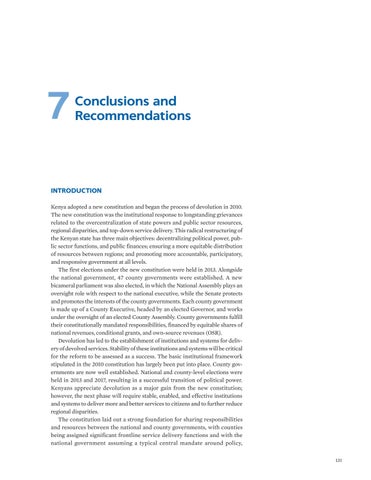7
Conclusions and Recommendations
INTRODUCTION Kenya adopted a new constitution and began the process of devolution in 2010. The new constitution was the institutional response to longstanding grievances related to the overcentralization of state powers and public sector resources, regional disparities, and top-down service delivery. This radical restructuring of the Kenyan state has three main objectives: decentralizing political power, public sector functions, and public finances; ensuring a more equitable distribution of resources between regions; and promoting more accountable, participatory, and responsive government at all levels. The first elections under the new constitution were held in 2013. Alongside the national government, 47 county governments were established. A new bicameral parliament was also elected, in which the National Assembly plays an oversight role with respect to the national executive, while the Senate protects and promotes the interests of the county governments. Each county government is made up of a County Executive, headed by an elected Governor, and works under the oversight of an elected County Assembly. County governments fulfill their constitutionally mandated responsibilities, financed by equitable shares of national revenues, conditional grants, and own-source revenues (OSR). Devolution has led to the establishment of institutions and systems for delivery of devolved services. Stability of these institutions and systems will be critical for the reform to be assessed as a success. The basic institutional framework stipulated in the 2010 constitution has largely been put into place. County governments are now well established. National and county-level elections were held in 2013 and 2017, resulting in a successful transition of political power. Kenyans appreciate devolution as a major gain from the new constitution; however, the next phase will require stable, enabled, and effective institutions and systems to deliver more and better services to citizens and to further reduce regional disparities. The constitution laid out a strong foundation for sharing responsibilities and resources between the national and county governments, with counties being assigned significant frontline service delivery functions and with the national government assuming a typical central mandate around policy, 131


